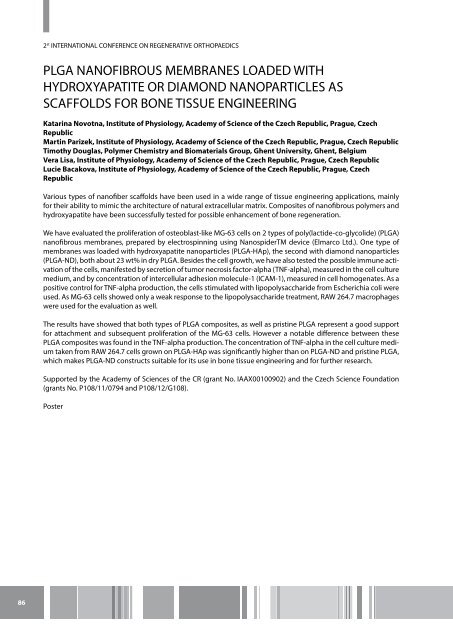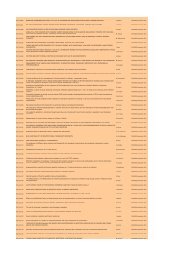Profilaksa DVT kod velikih ortopedskih operacija - Depol ...
Profilaksa DVT kod velikih ortopedskih operacija - Depol ...
Profilaksa DVT kod velikih ortopedskih operacija - Depol ...
Create successful ePaper yourself
Turn your PDF publications into a flip-book with our unique Google optimized e-Paper software.
86<br />
2 st INTERNATIONAL CONFERENCE ON REGENERATIVE ORTHOPAEDICS<br />
PLGA NANOFIBROUS MEMBRANES LOADED WITH<br />
HYDROXYAPATITE OR DIAMOND NANOPARTICLES AS<br />
SCAFFOLDS FOR BONE TISSUE ENGINEERING<br />
Katarina Novotna, Institute of Physiology, Academy of Science of the Czech Republic, Prague, Czech<br />
Republic<br />
Martin Parizek, Institute of Physiology, Academy of Science of the Czech Republic, Prague, Czech Republic<br />
Timothy Douglas, Polymer Chemistry and Biomaterials Group, Ghent University, Ghent, Belgium<br />
Vera Lisa, Institute of Physiology, Academy of Science of the Czech Republic, Prague, Czech Republic<br />
Lucie Bacakova, Institute of Physiology, Academy of Science of the Czech Republic, Prague, Czech<br />
Republic<br />
Various types of nanofiber scaffolds have been used in a wide range of tissue engineering applications, mainly<br />
for their ability to mimic the architecture of natural extracellular matrix. Composites of nanofibrous polymers and<br />
hydroxyapatite have been successfully tested for possible enhancement of bone regeneration.<br />
We have evaluated the proliferation of osteoblast-like MG-63 cells on 2 types of poly(lactide-co-glycolide) (PLGA)<br />
nanofibrous membranes, prepared by electrospinning using NanospiderTM device (Elmarco Ltd.). One type of<br />
membranes was loaded with hydroxyapatite nanoparticles (PLGA-HAp), the second with diamond nanoparticles<br />
(PLGA-ND), both about 23 wt% in dry PLGA. Besides the cell growth, we have also tested the possible immune activation<br />
of the cells, manifested by secretion of tumor necrosis factor-alpha (TNF-alpha), measured in the cell culture<br />
medium, and by concentration of intercellular adhesion molecule-1 (ICAM-1), measured in cell homogenates. As a<br />
positive control for TNF-alpha production, the cells stimulated with lipopolysaccharide from Escherichia coli were<br />
used. As MG-63 cells showed only a weak response to the lipopolysaccharide treatment, RAW 264.7 macrophages<br />
were used for the evaluation as well.<br />
The results have showed that both types of PLGA composites, as well as pristine PLGA represent a good support<br />
for attachment and subsequent proliferation of the MG-63 cells. However a notable difference between these<br />
PLGA composites was found in the TNF-alpha production. The concentration of TNF-alpha in the cell culture medium<br />
taken from RAW 264.7 cells grown on PLGA-HAp was significantly higher than on PLGA-ND and pristine PLGA,<br />
which makes PLGA-ND constructs suitable for its use in bone tissue engineering and for further research.<br />
Supported by the Academy of Sciences of the CR (grant No. IAAX00100902) and the Czech Science Foundation<br />
(grants No. P108/11/0794 and P108/12/G108).<br />
Poster




